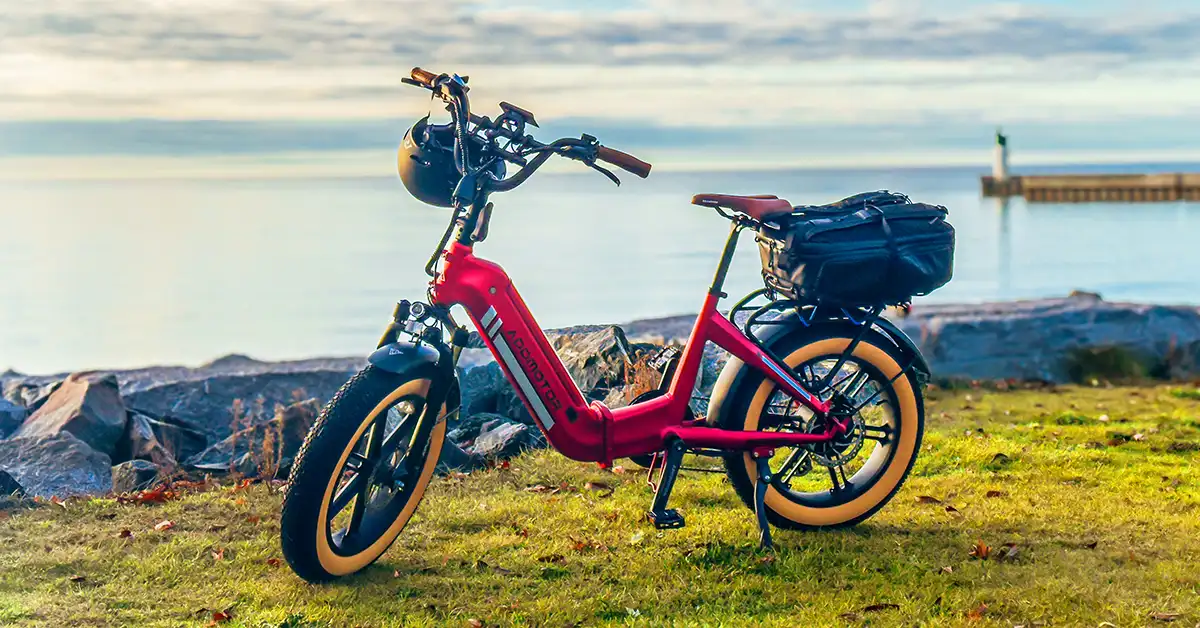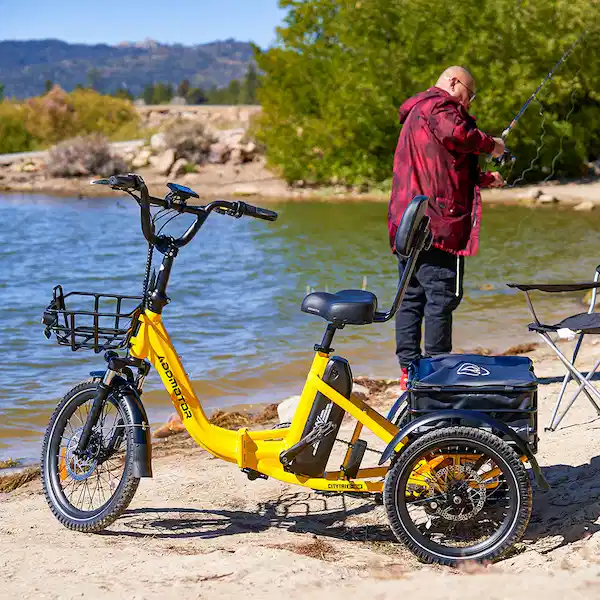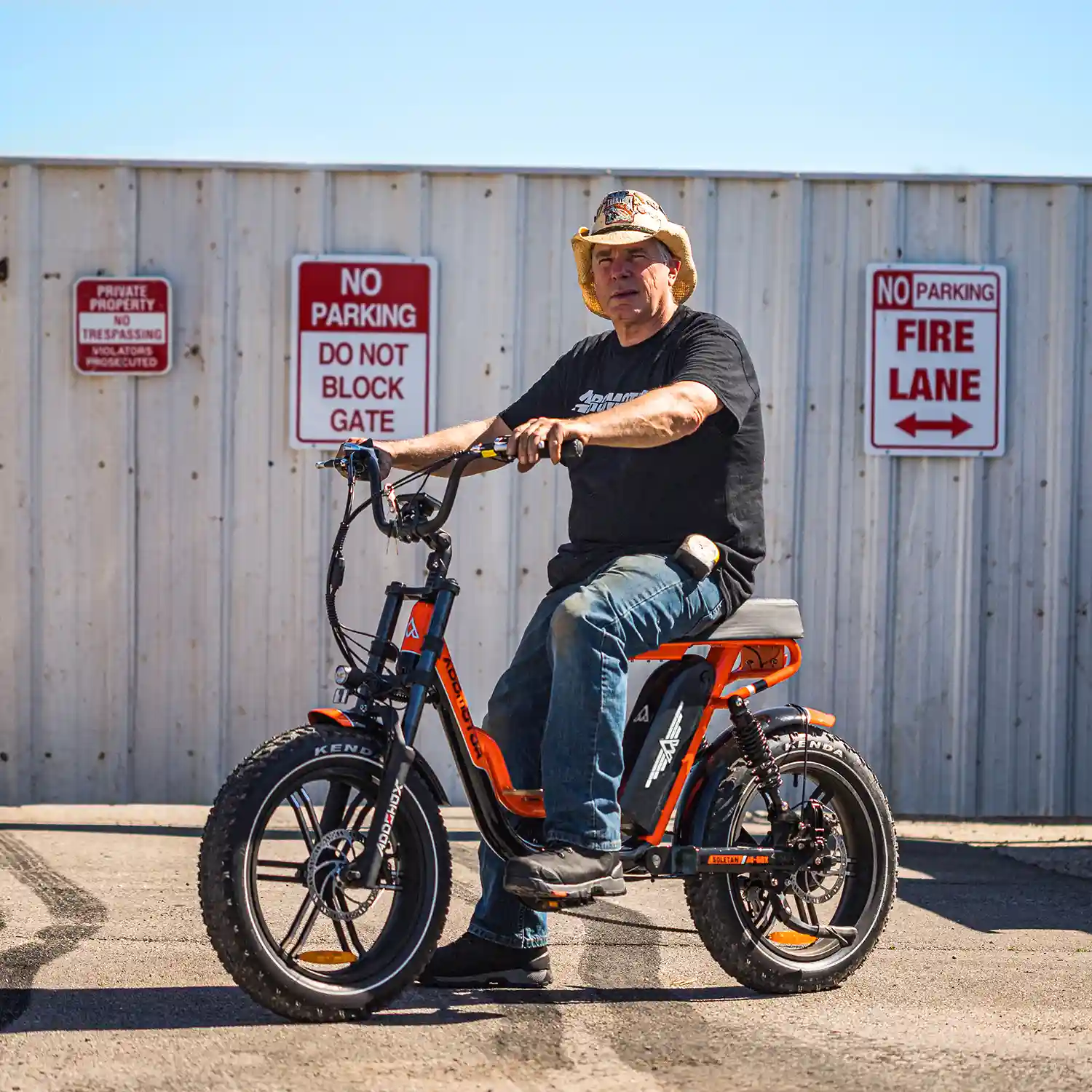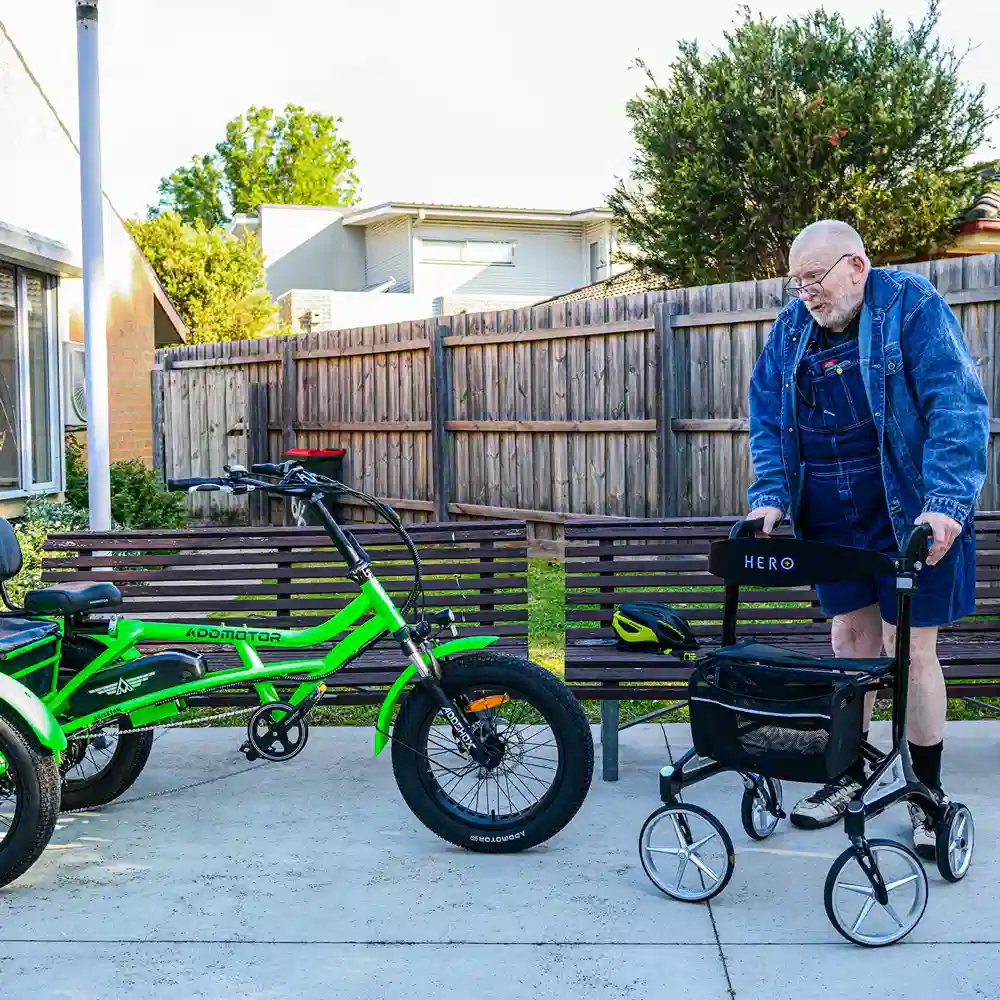How to Choose the Perfect Electric Bike | Addmotor Guide
By Addmotor | 25 January 2025 | 0 Comments

As cities grow more crowded, people are searching for transportation options that save them time, money, and stress.
Electric bikes are becoming more popular because they offer a cleaner, greener way to navigate crowded roads and are surprisingly simple to ride. The combination of pedal power and motor assistance makes uphill climbs and long distances easier and less tiring.
But with so many choices out there, how do you find the right one?
This guide will help you pick an electric bike that suits your lifestyle, meets your budget, and gives you the kind of ride you’ll look forward to every day.
1. Understanding Electric Bikes
What Is an Electric Bike?
An e-bike is a regular bicycle equipped with a small battery-powered motor that helps you while you pedal. You can choose how much effort you want to put in, and the motor will do the rest.The key components of an electric bike are:
- Motor: This is what gives the bike its extra push. It’s usually located in the front wheel hub, rear wheel hub, or near the pedals.
- Battery: Batteries store the energy the motor uses. They come in various capacities, which affects how far and fast you can ride. They can be removable (so you can charge them indoors) or fixed to the frame.
- Controller/Display: This is typically a small screen or panel on the handlebar that lets you switch between different pedal assistance levels and monitor battery life, speed, and distance.
- Pedals: E-bikes still have pedals, so you can ride them like regular bicycles whenever you want. If you don’t feel like pedaling, some models have a throttle that can power the bike without pedaling at all.
Types of Electric Bikes
Here are some common types of electric bikes to consider:- Electric Commuter Bikes: These are perfect for daily rides to work, running errands, or weekend city tours. They’re designed with comfort in mind and often feature a more upright riding position, fenders to keep you clean, and racks for carrying stuff.
- Folding Electric Bikes: These are ideal for those short on storage space or who commute partly by train or bus. These e-bikes fold into a compact size for easy storage under a desk or in a closet.
- Cargo Electric Bikes: Need to haul groceries, kids, or extra gear? Cargo e-bikes feature extended frames and sturdy racks, making them super practical for families or small business deliveries.
- Mountain E-Bikes: If you love the outdoors, a mountain electric bike can open up a whole new world of exploration. These electric bicycles are built with tough frames, powerful motors, and shocks or suspension to handle rough trails and steep climbs.
- 3-Wheel Electric Bikes (Trikes): A 3 wheel electric bike is great if you want a stable ride. They’re popular among folks who want extra balance support or cargo capacity. The third wheel adds stability and often allows for a bigger rear basket or cargo box.
- 2 Seat Electric Bikes:These e-bikes feature extended seats or a special frame design to carry an additional passenger. They are perfect for couples, friends, or parents wanting to bring a child along.
- Folding Electric Bikes: These are ideal for those short on storage space or who commute partly by train or bus. These e-bikes fold into a compact size for easy storage under a desk or in a closet.
- Cargo Electric Bikes: Need to haul groceries, kids, or extra gear? Cargo e-bikes feature extended frames and sturdy racks, making them super practical for families or small business deliveries.
- Mountain E-Bikes: If you love the outdoors, a mountain electric bike can open up a whole new world of exploration. These electric bicycles are built with tough frames, powerful motors, and shocks or suspension to handle rough trails and steep climbs.
- 3-Wheel Electric Bikes (Trikes): A 3 wheel electric bike is great if you want a stable ride. They’re popular among folks who want extra balance support or cargo capacity. The third wheel adds stability and often allows for a bigger rear basket or cargo box.
- 2 Seat Electric Bikes:These e-bikes feature extended seats or a special frame design to carry an additional passenger. They are perfect for couples, friends, or parents wanting to bring a child along.
2. Key Considerations When Choosing an Electric Bike
When shopping for an electric bike, it’s easy to get lost in all the specs, features, and shiny add-ons. But focusing on what truly matters—your needs, preferences, and constraints—will help you narrow down the choices quickly.Here are the major factors to keep in mind:
Your Riding Purpose
Think about why you want an electric bike.Your answer will guide you toward the right type. For example:
- If you plan to ride to work or school every day, get a commuter e-bike with features like integrated lights, fenders, and a comfortable saddle.
- If you’re more into weekend fun or fitness, a lighter electric bike (maybe with some suspension) could be your best bet.
- Need to haul groceries or heavier loads? Consider a cargo e-bike or a sturdy 3-wheel electric bike that offers more stability and carrying capacity.
Range and Battery Life
It’s crucial to know how far you can go on a single charge. Hence, see the battery’s watt-hour (Wh) rating before buying an e-bike.You might not need a big battery if you’re only taking short trips, but a higher-capacity battery is recommended for traveling longer distances or exploring off-the-beaten-path areas.
Motor Power and Placement
A more powerful motor can help you tackle steeper hills or carry heavier loads. But power also affects battery usage and sometimes the bike’s weight.Placement matters, too:
- Hub Motors: These are located in the front or rear wheel. Rear hub motors can offer a more natural feel when accelerating.
- Mid-Drive Motors: Positioned near the pedals, they provide balanced weight distribution and better hill-climbing ability but can be more expensive.
Frame Style and Fit
E-bikes come in step-over, step-through, or semi-recumbent frame styles.A step-through frame can be great for easy mounting and dismounting if you have mobility concerns or plan to ride in everyday clothes. A semi-recumbent 3 wheel electric bike takes it further by offering greater comfort and stability for riders with physical limitations.
Additionally, check the frame size, seat comfort, handlebar position, and overall ride feel.
Weight
Electric bikes are heavier than regular bicycles because of the motor and battery. If you’ll carry your bike upstairs or onto a rack often, look for a lighter model or one with a removable battery.Local Regulations
Check your local laws regarding speed limits, maximum motor power, and where e-bikes are allowed to ride. This can help you decide which bike category to focus on (Class 1, Class 2, or Class 3).3. Safety Features to Look For
Electric bikes might have more power and weight than regular bicycles, so you must look for features that keep you protected and visible on the road.Braking Systems
A good set of brakes can make all the difference in an emergency. There are two main types:- Disc Brakes: These provide strong, consistent stopping power in various weather conditions, which is especially important if you’re riding at higher speeds, climbing steep hills, or carrying cargo.
- Rim Brakes: These use pads that press against the wheel’s rim. They’re often cheaper and lighter but can lose efficiency in wet or muddy conditions.
Lighting and Reflectors
Being visible to others on the road is half the battle when it comes to safety. Make sure your e-bike has:Front Light: Essential for seeing and being seen, especially during early morning or late evening rides.
Rear Light: Alerts drivers and other cyclists to your presence from behind.
Reflectors: Typically placed on the pedals, wheels, and frame for added visibility.
Some e-bikes come with integrated LED lighting systems that are powered by the main battery. This is a handy feature since you don’t need separate batteries for your lights.Tires and Suspension
The right tires and suspension setup can significantly improve ride quality and safety.Wider tires with good tread are ideal for city streets with potholes or mild off-road terrain since they offer better grip and stability. If you plan to do a lot of off-roading, look for knobby tires designed for dirt and gravel. Fat tires can provide extra cushioning and stability, especially on uneven surfaces.
Meanwhile, a suspension fork or full suspension system can soften bumps and reduce the impact on your wrists and back while riding uneven roads or trails.
UL Certification
You might see references to UL 2271 (for batteries) and UL 2849 (for the entire e-bike system).When you see a UL-listed fat tire e-bike or other UL-certified models, it shows that the manufacturer is committed to meeting high safety standards and that the bike has gone through testing to ensure its electrical components are safe.
4. Additional Features and Accessories
Additional features and accessories can make your e-bike more convenient, tech-savvy, or just plain cool. Here are a few you might want to consider:Integrated Tech Features
- LCD Displays: Many electric bikes come with a small display showing speed, distance traveled, and battery life to help you track how far you’ve gone and how much juice is left.
- Smartphone Connectivity: Some modern e-bikes let you connect your phone to the bike’s system via Bluetooth. This allows you to access GPS navigation, track your rides, or adjust motor settings.
- GPS Tracking: If you’re worried about theft, bikes with built-in GPS can be tracked if they ever go missing.
Storage and Accessories
Depending on what you plan to use your e-bike for, the following items can be incredibly useful:- Racks and Panniers: These are great for holding groceries, a laptop, or workout gear. A sturdy rack lets you attach pannier bags, which can be easily removed when you reach your destination.
- Baskets: A basket is a classic choice for quick trips, especially on commuter or folding e-bikes. They come in all shapes and sizes, and some are even detachable.
- Trike Cargo Capacity: If you opt for a 3-wheel electric bike, you get the added bonus of a larger rear basket. This setup is perfect if you need serious storage space or want extra stability.
- Locks: Consider a sturdy U-lock or a heavy-duty chain lock if you’ll be parking your e-bike in public places.
Comfort Upgrades
- Adjustable Handlebars: Being able to tweak the height and angle of your handlebars can make a big difference on longer rides.
- Padded Seat or Suspension Seatpost: This can turn a bumpy commute into a smooth cruise, especially when combined with wider tires or front suspension.
- Fenders and Mudguards: These are not the most glamorous accessories but are necessary to avoid splashes from wet roads or puddles.
5. Budgeting and Value for Money
The cost of an electric bike can vary widely.While it might be tempting to jump on the cheapest option, it’s important to think about the long-term value. A higher-quality bike might save you money in maintenance costs and last longer overall.
Setting a Budget
Here’s a rough breakdown of what you can expect to find in each price range:· Entry-Level E-Bikes ($500–$1,500)
- Pros: Affordable, decent for short commutes, usually lighter and simpler.
- Cons: May have lower-quality components, smaller batteries, or less powerful motors. You might also miss out on advanced features like integrated lights or suspension.
· Mid-Range E-Bikes ($1,500–$3,000)
- Pros: This is the sweet spot for many riders. You can often get a reliable motor, a decent battery range, and some extras like a rear rack, front suspension, and parking brake.
- Cons: Not as many premium components as high-end models, but usually good enough for most everyday riders.
· High-End E-Bikes ($3,000 and above)
- Pros: Top-of-the-line components, long-lasting batteries, powerful motors, integrated tech, and sometimes more outstanding features like full suspension.
- Cons: Comes with a premium price tag. If you’re not an avid cyclist or you only ride short distances, you might not need all the extra features and advanced capabilities.
Evaluating Value
When choosing an electric bike, finding the right balance between features, quality, and budget is essential.Start by identifying must-have features like motor power, battery range, and frame type. Then, compare options within your range, focusing on build quality, brand reputation, and accessories.
Concluding Words
Buying an electric bike is an investment in your daily life. It’ll save you money on gas, parking fees, and maybe even a gym membership.If you’ll be riding regularly, prioritize quality and reliability. But if you plan to pedal casually around the neighborhood, a more basic model could fit the bill just fine.
Addmotor has a wide selection of e-bikes, including a few UL-certified models. Check out our latest models, compare features, and don’t hesitate to reach out if you have any questions. Happy shopping!
Leave a Reply
Your email address will not be published.Required fields are marked. *
Latest Stories


_1739850786.webp)

